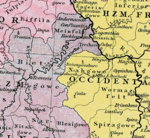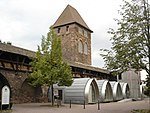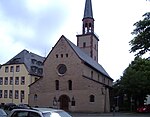Rhine Bridge (Worms)
Bridges in HesseBridges in Rhineland-PalatinateBridges over the RhineBuildings and structures in Worms, GermanyRailway bridges in Germany

The Worms Rhine Bridge (German: Rheinbrücke Worms) is a two-track railway bridge that spans the Rhine river to the north of Worms, Germany, forming part of the Worms–Biblis railway.
Excerpt from the Wikipedia article Rhine Bridge (Worms) (License: CC BY-SA 3.0, Authors, Images).Rhine Bridge (Worms)
Ludwigsmuehle,
Geographical coordinates (GPS) Address External links Nearby Places Show on map
Geographical coordinates (GPS)
| Latitude | Longitude |
|---|---|
| N 49.650555555556 ° | E 8.3730555555556 ° |
Address
Rheinbrücke Worms
Ludwigsmuehle
67547 , Worms-Nord (Stadtgebiet Nord)
Rhineland-Palatinate, Germany
Open on Google Maps











